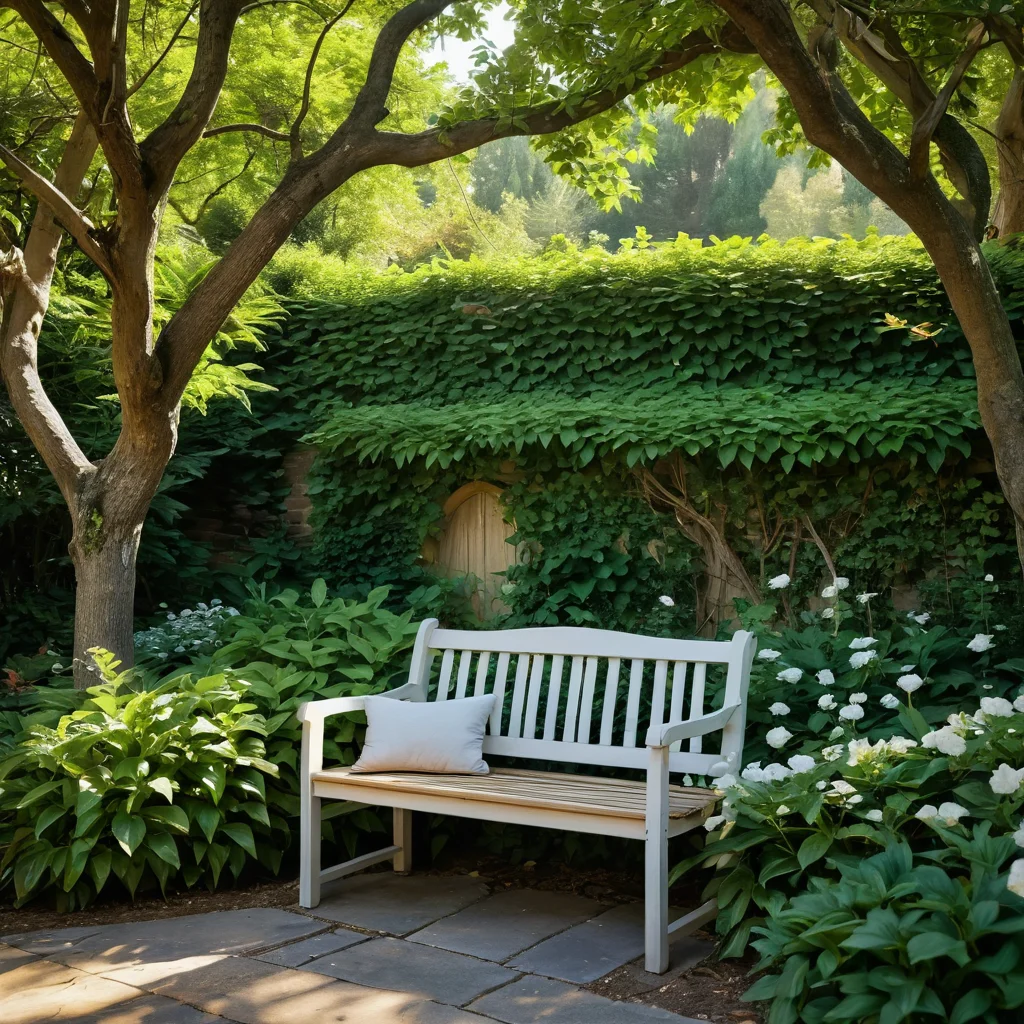Remember that feeling: a warm summer evening, a gentle breeze rustling the leaves of the trees, the air filled with the scent of herbs and flowers, and somewhere in the distance, water murmuring softly. In moments like these, time seems to slow down, and the hustle and bustle of the big world recedes. This is exactly the kind of place – your personal oasis of calm and harmony – that we will be creating today. A meditation garden is not just a beautifully designed plot; it is a space that helps you disconnect from everyday worries, find inner balance, and restore your energy.
Why You Need a Meditation Garden: Creating a Corner of Tranquility at Your Dacha
In our fast-paced era, when information bombards us from all sides and the rhythm of life constantly accelerates, the need for solitude and tranquility has become more relevant than ever. We often seek refuge in noisy cities, attend yoga studios or meditation centers, but what if the best place for inner harmony is right under your nose, at your own dacha?
A meditation garden is not just a trend. It is a conscious decision to create a space that will contribute to:
- Reducing stress and anxiety: Nature has a wonderfully calming effect. Contemplating greenery, listening to the sounds of nature, feeling the earth beneath your feet – all of this helps to relieve tension.
- Improving concentration and clarity of mind: The silence and tranquility of the garden promote focus, helping you understand yourself and your desires better.
- Restoring spiritual strength: A walk through such a garden, sitting on a comfortable bench, or simply observing insects and birds – all of this fills you with energy and positivity.
- Developing creative potential: A harmonious environment stimulates inspiration, helping you find new ideas and solutions.
- Strengthening the connection with nature: In a meditation garden, you can feel like a part of the larger world, experiencing unity with your surroundings.
Believe my experience, creating such a corner is not so much an expensive undertaking as a creative one. It’s an opportunity to bring more mindfulness, tranquility, and beauty into your life. You can start with a small plot, gradually developing it, or immediately begin creating a full-fledged garden that will become your personal sanctuary from the hustle and bustle.
Types of Meditation Gardens: From Japanese Zen Gardens to Modern Minimalism
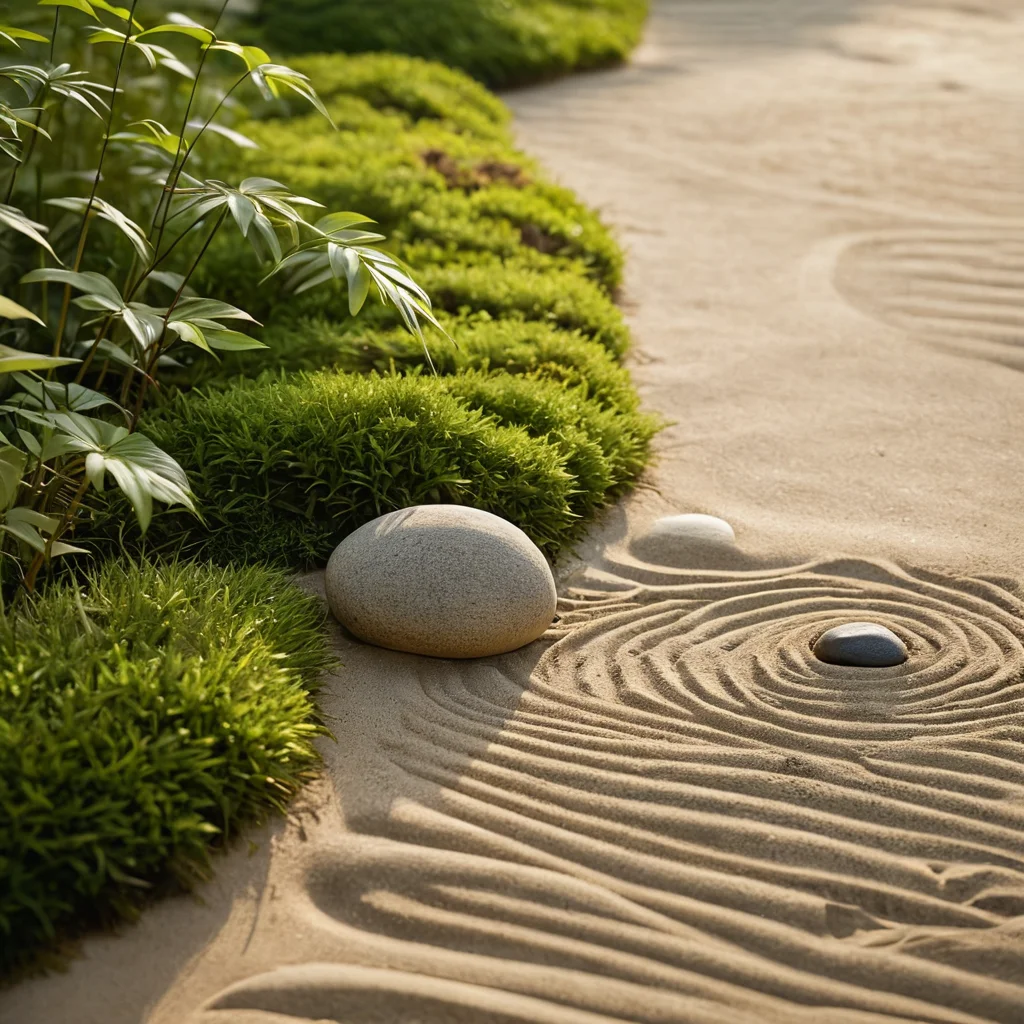
When we talk about a meditation garden, the first thing that comes to mind is, of course, the Japanese rock garden, or Zen garden. And this is no accident, as it was the Japanese who, for centuries, honed the art of creating spaces conducive to peace and self-discovery. But the world of garden design is much richer, and there are many styles that are perfectly suited for creating a meditative atmosphere.
Japanese Garden
This is a classic of the genre. Its main principles are asymmetry, naturalness, minimalism, and symbolism. There is nothing superfluous in such a garden. The main elements:
- Stones: They symbolize mountains, islands, animals. They are placed thoughtfully, creating a sense of stability and eternity.
- Gravel or sand: Often used to imitate water. It is regularly raked to create patterns that symbolize ripples on the water or the passage of time.
- Plants: Most often, these are low-growing trees (maples, pines), mosses, and ferns. Their shape and texture are important, not lush flowering.
- Water features: A small pond with koi carp or even just a bowl of water.
- Landscape elements: Bridges, lanterns, gazebos (tea houses).
The Japanese garden teaches us to see beauty in simplicity, find harmony in asymmetry, and appreciate every moment.
English Landscape Garden
Unlike the Japanese garden, the English garden is more lush and romantic. Naturalness is valued here, but in a softer, “tamed” form. Elements that will help create a meditative atmosphere:
- Winding paths: They invite leisurely strolls, creating a sense of mystery and exploration.
- Shady nooks: Secluded benches under spreading trees, gazebos covered in greenery.
- Water bodies: Small lakes, streams, waterfalls.
- Flowers and shrubs: Perennials creating continuous bloom, fragrant roses, lavender.
- Garden sculptures: Subtle, harmoniously integrated into the landscape.
The English garden encourages daydreaming, contemplation, and enjoyment of nature’s beauty.
Modern Minimalist Garden
This style is ideal for those who appreciate clean lines, simple forms, and functionality. The meditative effect is achieved through:
- Clear geometric shapes: Straight paths, rectangular or round flowerbeds.
- Limited color palette: Monochrome solutions or combinations of 2-3 main colors are often used.
- Use of natural materials: Stone, wood, concrete.
- Emphasis on textures: Various textures of plants, stones, surfaces.
- Minimal decor: One or two expressive elements, such as a sculpture or a stone composition.
Minimalism helps to focus on what’s important, remove excess “noise,” and achieve clarity.
Cottage (Country) Garden
If you love everything natural, cozy, and a bit “wild,” then this style is for you. It creates an atmosphere of peace and tranquility through:
- Abundance of flowers: Lush, often self-seeding flowerbeds where plants grow freely next to each other.
- Use of natural materials: Wooden fences, wattle fences, old bricks.
- Simple forms: Unpretentiousness and naturalness in everything.
- Creation of secluded nooks: Benches overgrown with greenery, hammocks.
A country garden gives a feeling of home, warmth, and serenity.
When choosing a style, focus on your feelings and preferences. The main thing is that the garden evokes a sense of peace and harmony in you.
Key Elements of a Meditation Garden: Plants, Stones, Water, and Decor
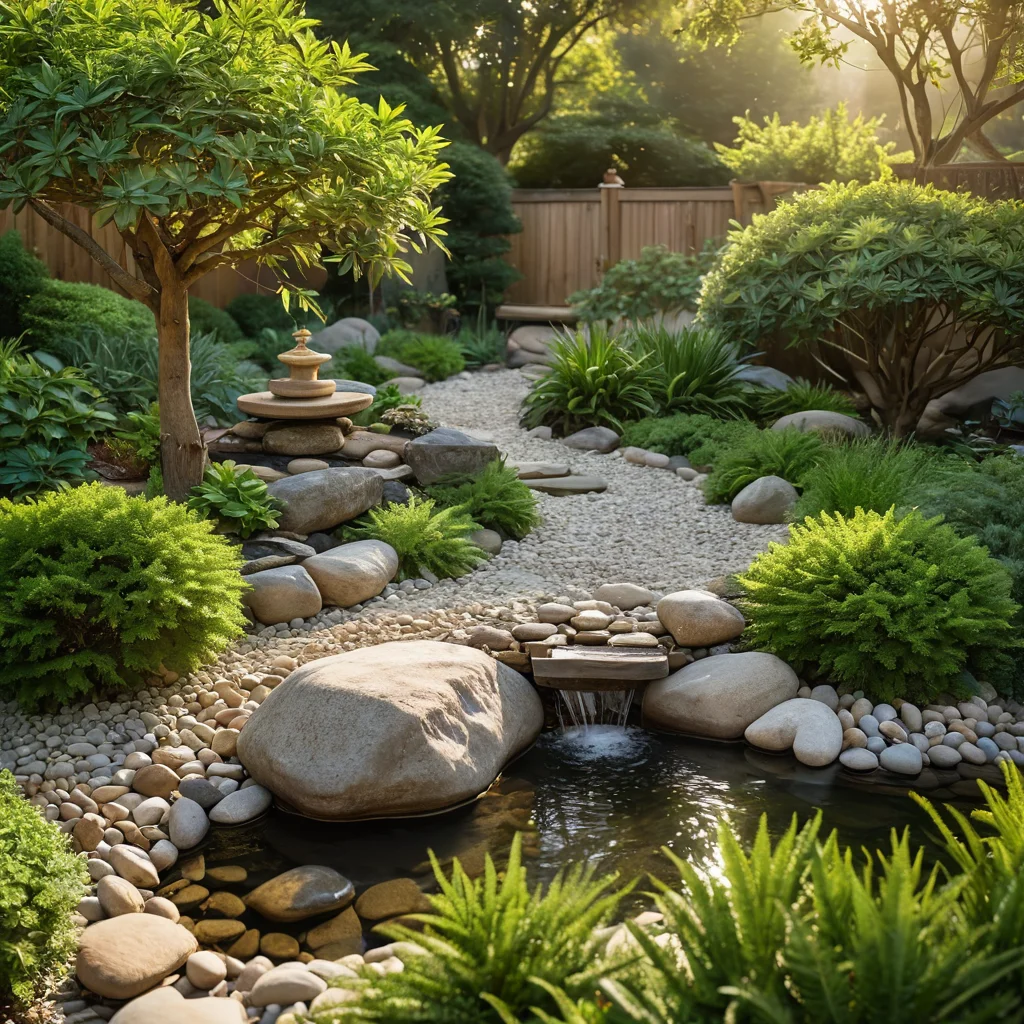
Creating a meditation garden is not just about arranging beautiful objects. It is a thoughtful combination of elements that work together to create a special atmosphere. Let’s break down the key components.
Plants
Plants are the soul of any garden, and in a meditation garden, they play a special role. It is important to choose:
- Aromatic plants: Lavender, lemon balm, mint, sweet pea, roses, mock orange. Their aroma is calming and relaxing.
- Plants with interesting textures: Ferns, hostas, grasses, sedums. They add tactile sensations and visual diversity to the garden.
- Plants symbolizing peace and longevity: Bamboo (if climate and space allow), pines, junipers, which remain green year-round.
- Berry and fruit-bearing plants: If you want to add functionality to the garden. Blueberries, lingonberries, fruit bushes – their presence reminds us of nature’s cycles.
- Low-maintenance plants: So that the garden does not require too much of your time and effort. Less is more.
Examples of successful combinations:
- Lavender + sage + Hylotelephium spectabile
- Hostas (various varieties) + ferns + heucheras
- Grasses (fescue, miscanthus) + ornamental grasses
Important: Avoid overly bright, flashy colors that can be distracting. Opt for calm, natural shades.
Stones
Stones are the foundation of many meditative gardens, especially Japanese ones. They symbolize stability, strength, and eternity.
- Types of stones: Use natural stone – granite, quartzite, sandstone. They look the most harmonious.
- Sizes: Combine stones of different sizes – from large boulders to small pebbles.
- Placement: Stones can be arranged in groups, individually, or used to create compositions that imitate mountains or islands. Japanese gardens often use groups of 3, 5, or 7 stones.
- Gravel and sand: For imitating water or creating patterns.
Ideas for the garden:
- A natural stone path.
- A small rock garden or alpine slide with thoughtful stone placement.
- A dry stream made of pebbles or gravel.
- A large boulder standing alone as an accent.
Water
Water is a symbol of life, purification, and tranquility. Its murmur is soothing.
- Pond: A classic option, it can be decorative or stocked with inhabitants (fish, aquatic plants).
- Stream: An artificial or dry stream (made of stones and gravel).
- Fountain: A small, quiet fountain or even just a bowl of water.
- Cascade: Creates the pleasant sound of falling water.
If you don’t have the opportunity to create a full-fledged water feature, you can use decorative fountains, bowls of water, or even just a vase of water with flower petals falling into it.
Decor and Small Architectural Forms
The decor should be minimalist and functional.
- Benches and loungers: Comfortable places for rest and contemplation. It’s best to choose natural materials – wood, stone.
- Garden lanterns: Create a cozy atmosphere in the evening. It’s best to choose soft, diffused light.
- Sculptures: Minimalist, abstract, or nature-themed.
- Landscape accessories: Japanese lanterns, stone bowls, wind chimes that produce a quiet, melodious sound.
- Bridges: If your plot has a pond or dry stream.
The main rule: everything should be in moderation. Avoid cluttering with details to maintain harmony and tranquility.
How to Choose a Location and Plan a Meditation Garden: Tips for Any Plot
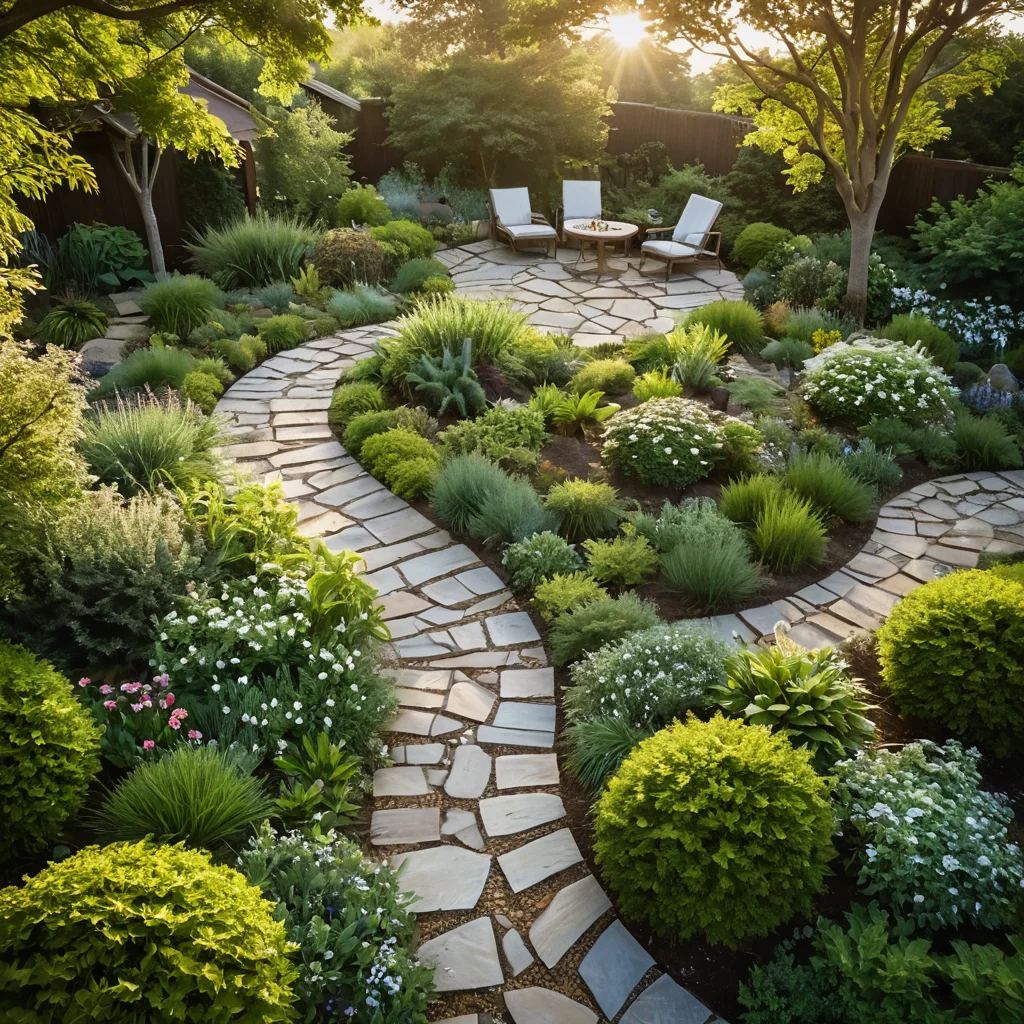
The location of your meditation garden is one of the most important factors influencing its atmosphere. Even on a small plot, you can create your own corner of tranquility if you approach planning wisely.
Choosing a Location
When choosing a spot for your meditative corner, pay attention to:
- Seclusion: Ideally, the spot should be as far as possible from noisy areas of the property (playground, barbecue area, entrance gate).
- Privacy: Ensure that your relaxation area is not visible from the windows of neighboring houses or from the adjacent property. Hedges, pergolas with climbing plants, or screens can be used to create privacy.
- Lighting: It’s important to find a balance. Complete shade can be uncomfortable, and scorching sun can be tiring. Ideally, a spot with diffused light, offering both sunny and shady areas.
- Views: Are there beautiful views from this spot of other parts of the garden, a forest, or a field? If not, you can create them with plants or decorative elements.
- Proximity to the house: For convenience of use, especially in cool weather, it’s desirable for the meditation garden to be located not far from the house.
- Possibility of water connection (for fountains, ponds): If you plan water features, consider the availability of water sources and electricity.
My personal advice: often the best spot is a far corner of the property that previously seemed “useless.” It can be transformed into a true paradise for the soul.
Planning the Space
After you’ve chosen the location, let’s move on to planning. It doesn’t matter if your plot is large or small; a few simple rules will help create a harmonious space:
Zoning
Even a small garden can be divided into zones:
- Contemplation zone: A secluded spot with a comfortable bench, armchair, or even just cushions on the ground, offering the best view.
- Walking zone: A winding path that leads through the garden, allowing you to enjoy every step.
- Accent zone: This could be a stone composition, a small water feature, an interesting plant, or a sculpture.
To visually divide the zones, you can use:
- Different types of ground cover (gravel, stone, mulch).
- Low borders or hedges.
- Groups of plants of different heights.
Creating Smooth Lines
Avoid sharp corners and straight lines. Smooth, curved shapes of paths and flowerbeds create a sense of naturalness and encourage relaxation. If you have a straight section, try to “soften” it by planting climbing plants around it or installing decorative elements.
Using Vertical Elements
Vertical elements add depth and interest to the garden:
- Pergolas and arches: Can serve as support for climbing plants and create cozy, secluded nooks.
- Trellises and screens: For vertical gardening.
- Tall plants: Trees, shrubs, grasses.
Symmetry and Asymmetry
Asymmetry is often used in meditative gardens as it appears more natural. However, moderate use of symmetry (e.g., symmetrically placed bushes at the entrance to a contemplation zone) can add structure and order to the garden, which is also important for a sense of calm.
Sizes and Proportions
All elements of the garden should be proportional to the overall size of the plot. On a small plot, a large water feature or a giant sculpture would look out of place. It’s better to choose compact solutions.
Start with a simple sketch. Draw a plan of your plot and mark the main zones, paths, planting areas, and decorative elements. This will help avoid mistakes and make the garden creation process more manageable.
Creating a Meditation Garden with Your Own Hands: A Step-by-Step Guide
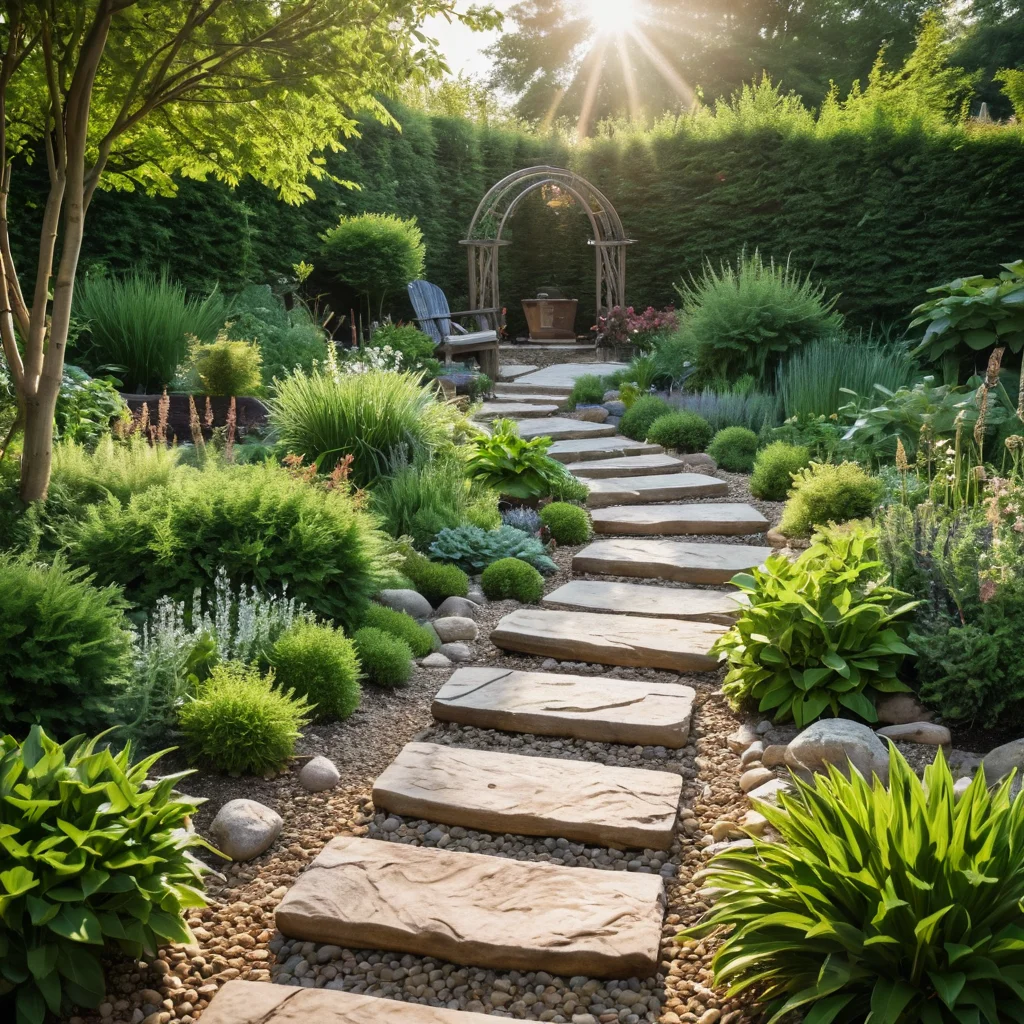
Transforming your plot into an oasis of tranquility with your own hands is a feasible task, even if you have no experience in landscape design. The main thing is to follow the plan and do everything with love. I always advise starting small, gradually expanding and supplementing your garden.
Step 1: Choosing the Location and Concept
As we’ve already discussed, this is the first and most important step. Decide which style you prefer: Japanese, minimalist, country? Determine where your meditation corner will be located, considering seclusion, privacy, and lighting.
Step 2: Preparing the Area
Clear the chosen area of weeds, debris, and old structures. If you plan a water feature or complex stone compositions, you may need to slightly level the surface or, conversely, create relief.
- Weeding: This can be done by hand-pulling or using covering materials.
- Loosening the soil: If plantings are planned, improve soil structure by adding compost or humus.
- Marking: Use stakes and string to outline the future paths, flowerbeds, and relaxation areas.
Step 3: Creating Paths and Zones
Paths are the “veins” of your garden. They should be comfortable and harmoniously fit into the overall concept.
- Materials: Natural stone (flagstone, pebbles), gravel, wooden decking, paving stones in calm tones. For a meditative garden, I would recommend avoiding bright tiles or asphalt.
- Shape: Winding, smooth lines are preferred.
- Laying: Ensure the path is comfortable for walking, not too narrow, and well-drained.
If you are planning relaxation areas, install benches, loungers, or simply create a space for cushions.
Step 4: Installing Water Features (if planned)
This can be the most challenging stage, but the result is worth it.
- Pond: Dig a pit of the desired shape, lay waterproofing material (film or a special basin), secure the edges, cover the bottom with gravel or sand, and fill with water.
- Stream: Create a shallow depression, line the bottom with waterproofing material, then lay stones and gravel to imitate the flow.
- Fountain: Install the pump, decorative element (bowl, figurine), and connect to the water and electricity source.
Important: If you are unsure of your abilities, start with something simple – a decorative bowl of water or a small dry stream. This will already add dynamism and tranquility to the garden.
Step 5: Planting
Choose plants considering the plot’s lighting, soil type, and your preferences. Create multi-layered compositions, combining different textures and shades.
- First, large plants: Trees and shrubs that will form the structure of the garden.
- Then perennials: Creating the main volume of the flowerbeds.
- And finally, ground cover plants and flowers: Filling in gaps and adding color.
Don’t forget about aromatic plants and those that create pleasant textures.
Step 6: Arranging Decor and Small Architectural Forms
Now you can add the finishing touches.
- Benches: Place them in spots with the best views or in secluded corners.
- Stone compositions: Arrange boulders, pebbles, create the desired gravel pattern.
- Garden lanterns: Place them along paths or near the relaxation area.
- Decorative elements: If you decide to use sculptures, lanterns, wind chimes – place them so they don’t overload the space but serve as accents.
Step 7: Final Touches
Check if everything looks harmonious. Clean up construction debris. You can add mulch to the flowerbeds. Your meditation garden is ready!
Remember, a garden is a living organism. It will change, grow, and develop with you. The main thing is to enjoy the process of creating it and savor the result.
Water Features in a Meditation Garden: Pond, Stream, or Fountain – What to Choose?
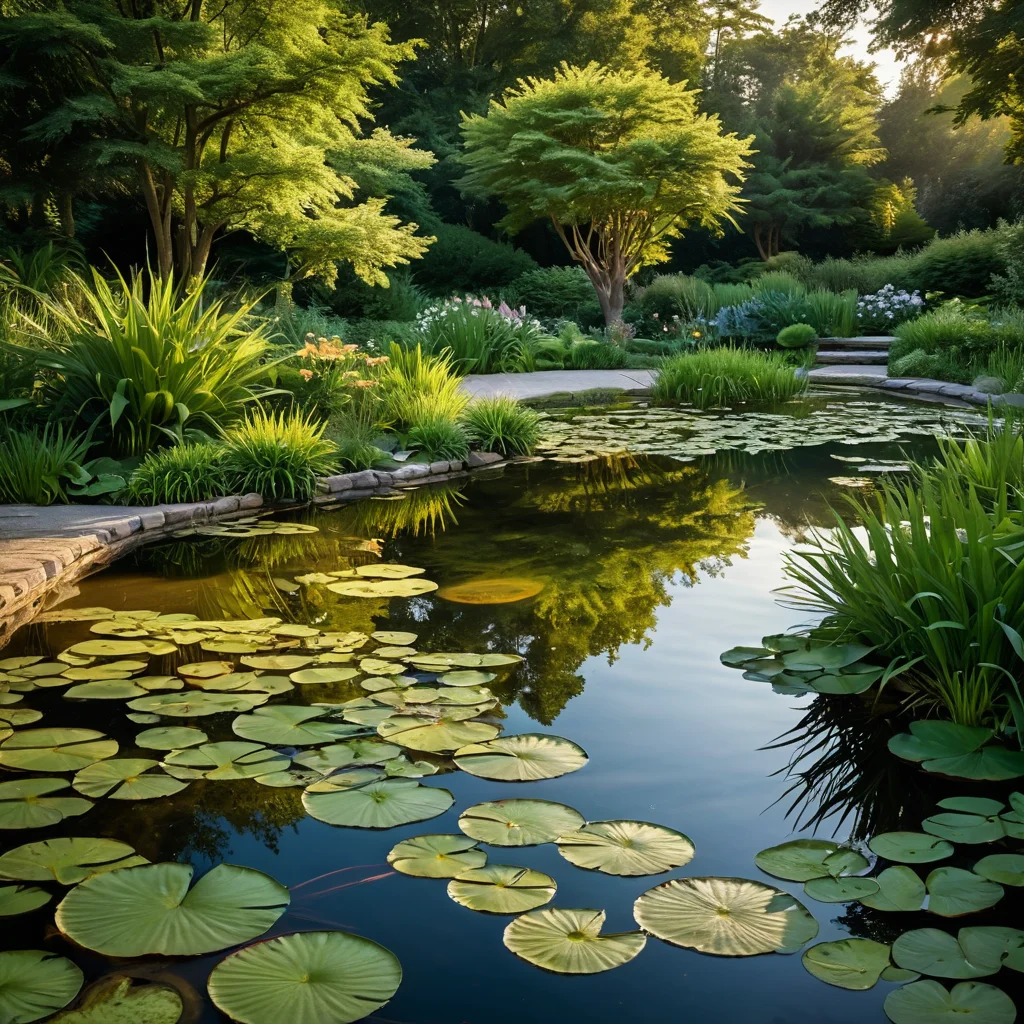
Water is one of the most powerful elements that contribute to creating an atmosphere of calm and tranquility. Its smooth movement, reflections of the sky and plants, and soothing sound – all have a beneficial effect on our state. But what to choose: a pond, a stream, or a fountain? The answer depends on the size of your plot, your budget, and personal preferences.
Pond
A pond is a classic solution that can become a true garden adornment. It can be of various sizes and shapes, from a small pond to an impressive water body.
- Advantages:
- Creates a sense of depth and tranquility.
- Can be home to aquatic plants (water lilies, cattails) and fish (koi, goldfish).
- Acts as a natural air humidifier.
- Reflects the sky and greenery, visually expanding the space.
- Disadvantages:
- Requires significant space and financial investment.
- Requires regular maintenance (cleaning, water quality control, aeration).
- Can be dangerous for small children, requires fencing.
- Ideal for: Spacious plots where it’s possible to create a sufficiently large water body.
Stream
A stream adds dynamism and naturalness to the garden. It can flow across the entire plot or be a short, picturesque element.
- Advantages:
- The sound of flowing water is very calming.
- Visually connects different parts of the garden.
- Can be created even on a small plot.
- Easier to integrate into an existing landscape.
- Disadvantages:
- Requires careful design to ensure water actually flows and doesn’t stagnate.
- May require pumping equipment.
- Maintenance can be more labor-intensive than for a static pond.
- Ideal for: Plots with natural or artificially created elevation changes.
Fountain
A fountain is an elegant solution that adds sophistication and melody to the garden.
- Advantages:
- Does not require much space, can be installed even on a small terrace or balcony.
- The sound of falling water creates a relaxing atmosphere.
- There is a huge variety of models – from classic bowls to modern sculptures.
- Relatively easy to install and maintain.
- Disadvantages:
- Requires constant access to electricity.
- Water can evaporate, requiring regular refilling.
- The noise from some fountains can be intrusive.
- Ideal for: Small gardens, patios, terraces, or as an accent element in a larger composition.
Dry Stream
This is an excellent alternative for those who are not ready for the complexities associated with real water bodies.
- Advantages:
- Easy to create and maintain.
- Imitates the flow of water, creating a visual effect.
- Can be decorated with stones, pebbles, plants.
- Does not require pumps or waterproofing.
- Disadvantages:
- Absence of the sound of flowing water.
- Imitation, not real water.
- Ideal for: Almost any plot, especially those with water or budget limitations.
My advice: If you are in doubt, start with a dry stream or a small fountain. You can always expand the water composition in the future if you feel it’s necessary. The main thing is that the sound and sight of water bring you joy and peace.
Meditation Garden Care: How to Maintain Harmony and Tranquility
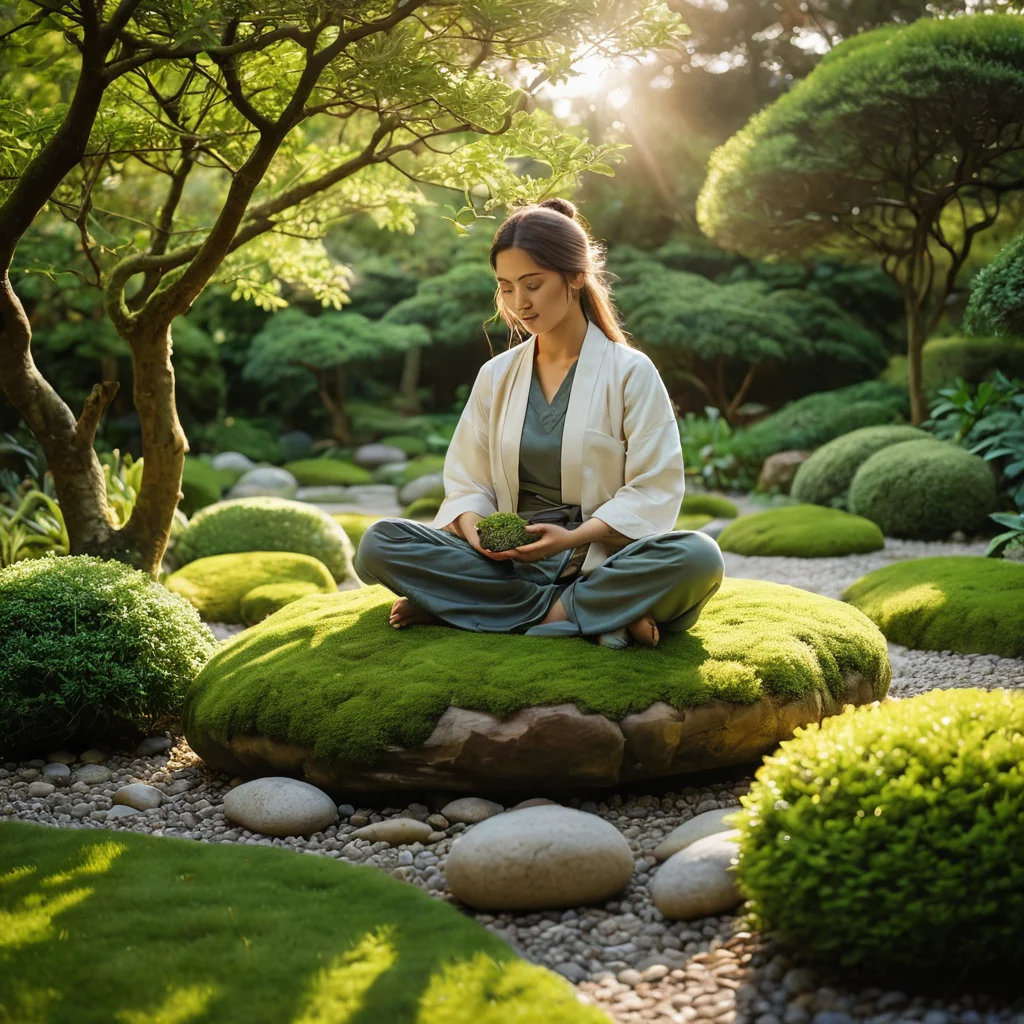
A meditation garden is a place where you seek harmony and tranquility. And for it to always remain so, it needs careful and, most importantly, unobtrusive care. Believe me, maintaining order in such a garden does not require titanic efforts and even brings pleasure.
Basic Principles of Care
The main rule is minimal intervention. We strive for naturalness, so:
- Avoid excessive “tidiness”: A slight natural messiness looks more organic in a meditative garden than perfectly trimmed lawns and bushes.
- Work with nature, not against it: If some plants grow well on their own, don’t ruthlessly uproot them.
- Regularity is more important than volume: It’s better to spend a little time on the garden once a week than to do a major cleanup once a month.
Specific Care Tasks
Here is a sample list of tasks that will help your garden remain beautiful and peaceful:
- Weeding: This is perhaps the most important task. Regularly remove weeds so they don’t choke out ornamental plants. It’s best to do this after rain when the soil is soft.
- Watering: Water plants as needed, especially during hot, dry weather. Try to water in the morning or evening to avoid rapid moisture evaporation.
- Maintaining cleanliness: Remove fallen leaves (especially from paths), dry flowers, and debris. This will take a little time but will transform your garden.
- Caring for water features:
- Pond: Remove algae, monitor water clarity, add water if necessary. If the pond has fish, monitor their health.
- Fountain: Clean the bowl of buildup, check the pump’s operation.
- Dry stream: Remove fallen leaves and debris, smooth out the gravel.
- Fertilizing plants: Most low-maintenance plants for a meditative garden do not require frequent fertilization. It’s enough to apply compost or special fertilizers for ornamental plants once a year (in spring).
- Pruning: Perform sanitary pruning (removing dry, damaged branches) as needed. Only do formative pruning if it’s necessary to maintain the style (e.g., in a Japanese garden).
- Caring for paths and surfaces: Sweep, wash with water if necessary. Remove grass growing between slabs or stones.
- Caring for furniture: Wooden furniture should be treated with protective agents periodically. Stone furniture should simply be cleaned of dust and dirt.
Seasonal Care
Spring:
- Clearing the area of winter debris.
- Sanitary pruning of shrubs and trees.
- Applying fertilizers.
- Planting new plants.
- Checking and starting water features.
Summer:
- Regular watering.
- Weeding.
- Removing spent flower heads.
- Pest control (if any appear).
Autumn:
- Clearing fallen leaves.
- Preparing perennials for winter (pruning, covering).
- Winterizing water features (if necessary).
Winter:
- Protecting tender plants.
- Enjoying the winter garden.
Believe me, regular but not burdensome care will ensure your meditation garden always remains an ideal place for rest and rejuvenation. The main thing is to do it with pleasure, as part of a ritual of caring for your personal space of harmony.
Common Mistakes When Creating a Meditation Garden and How to Avoid Them
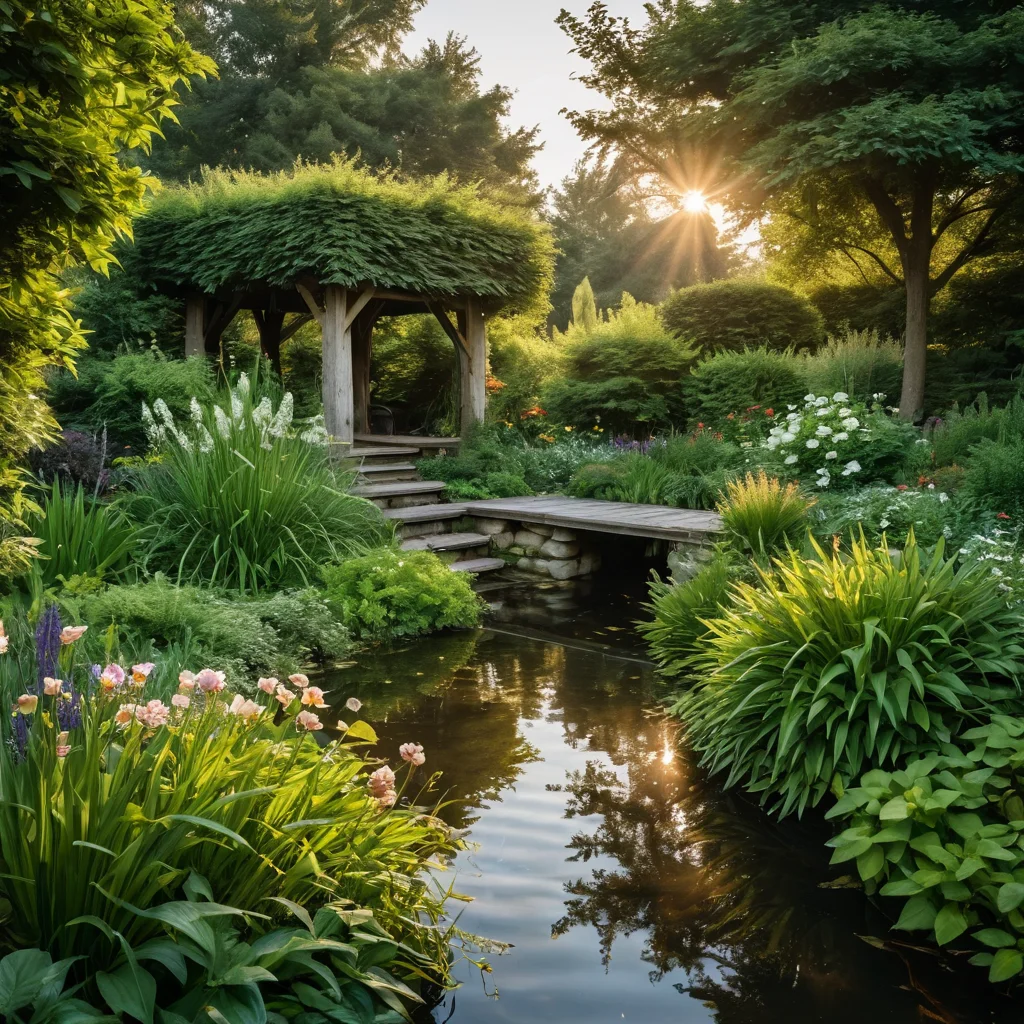
Creating a meditation garden is an engaging process, but like any endeavor, it has its pitfalls. To ensure your sanctuary of calm truly brings peace and not disappointment, it’s worth knowing about common mistakes and how to avoid them.
- Mistake 1: Overcrowding with Decor
The Problem: The desire to make the garden “more beautiful” leads to too many statuettes, figurines, and bright elements. Such a garden looks chaotic and distracts from the main purpose – contemplation and peace.
How to Avoid: Adhere to the principle of “less is more.” Each decorative element should be thoughtful and harmoniously integrated into the overall picture. It’s better to use fewer, but more expressive and high-quality, details.
- Mistake 2: Incorrect Plant Selection
The Problem: Using plants that are too demanding, aggressively spreading, or, conversely, dying in the given conditions. This leads to constant worries and disappointments.
How to Avoid: Choose low-maintenance, winter-hardy plants suitable for your climate and soil type. Opt for plants with interesting textures and calm color palettes. Research the characteristics of each plant before purchasing.
- Mistake 3: Ignoring Seclusion and Privacy
The Problem: The garden is created, but it lacks a sense of seclusion. It’s visible to neighbors, near a noisy road, or a children’s playground.
How to Avoid: Carefully choose the location for the garden. Use hedges, tall shrubs, pergolas, and screens to create natural “walls” that separate your space from the outside world. If possible, locate the meditation area away from noise sources.
- Mistake 4: Too Much “Active” Water
The Problem: Choosing a powerful fountain with turbulent water or a too-large waterfall. The sound of water in such cases is irritating rather than calming.
How to Avoid: For a meditative garden, it’s better to choose quiet, murmuring water features: small fountains, water bodies with gentle water flow, or even dry streams. The sound should be unobtrusive and pleasant.
- Mistake 5: Overly Complex Layout
The Problem: Creating confusing labyrinths of paths and complex flowerbed shapes in a small area. This looks unnatural and can cause discomfort.
How to Avoid: Strive for simplicity and naturalness. Use smooth, winding lines. In small plots, it’s better to limit yourself to one or two simple paths and concise shapes.
- Mistake 6: Lack of a Resting Place
The Problem: The garden is beautiful, but there’s nowhere to sit and contemplate peacefully. It’s just a walking area, not a place for meditation.
How to Avoid: Be sure to include a comfortable seating area: a comfortable bench, armchair, lounger, or even just a space for cushions. This spot should be positioned to offer the best view of the garden.
- Mistake 7: Ignoring Lighting
The Problem: The garden is beautiful during the day, but at night it becomes dark and unwelcoming, making it impossible to enjoy in the twilight.
How to Avoid: Plan a system of soft, diffused lighting. Use garden lanterns, string lights, and spotlights for individual plants or decorative elements. The light should create a cozy atmosphere, not illuminate everything as if it were daytime.
Remember that a meditation garden is your personal space. Listen to your feelings, experiment, and don’t be afraid to make mistakes. After all, the main thing is to create a place that will bring you joy, peace, and inspiration.
